Telehealth: Benefits, Challenges, and Impact on Nursing Practice
VerifiedAdded on 2021/06/15
|6
|919
|131
Report
AI Summary
This report explores the concept of telehealth, defining it as the use of telecommunication technologies to enhance healthcare delivery, education, and public health. It emphasizes the relevance of telehealth for advanced nurse practitioners, particularly family nurse practitioners, highlighting the skills needed to utilize telehealth effectively. The report discusses telehealth's importance in providing cost-effective healthcare, remote patient monitoring, and virtual consultations. It also examines the impact of telehealth on nursing practice, addressing the shortage of primary care providers and the aging population. Furthermore, the report outlines the pros and cons of telehealth, including increased patient care accessibility, cost reduction, equipment needs, and challenges in care continuity. The conclusion underscores the transformative influence of telehealth on the medical community, emphasizing the need for adequate training and addressing associated challenges.
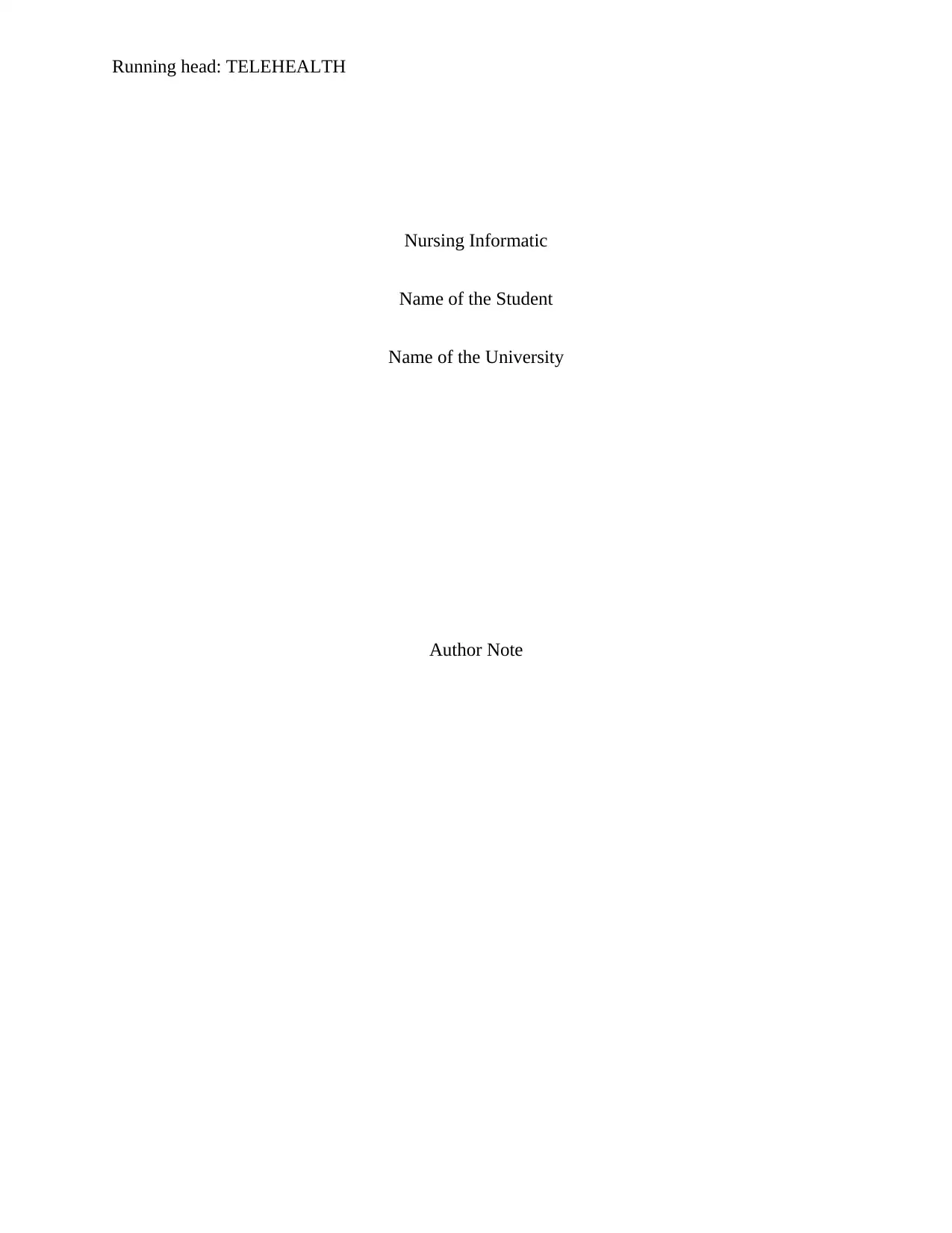
Running head: TELEHEALTH
Nursing Informatic
Name of the Student
Name of the University
Author Note
Nursing Informatic
Name of the Student
Name of the University
Author Note
Paraphrase This Document
Need a fresh take? Get an instant paraphrase of this document with our AI Paraphraser
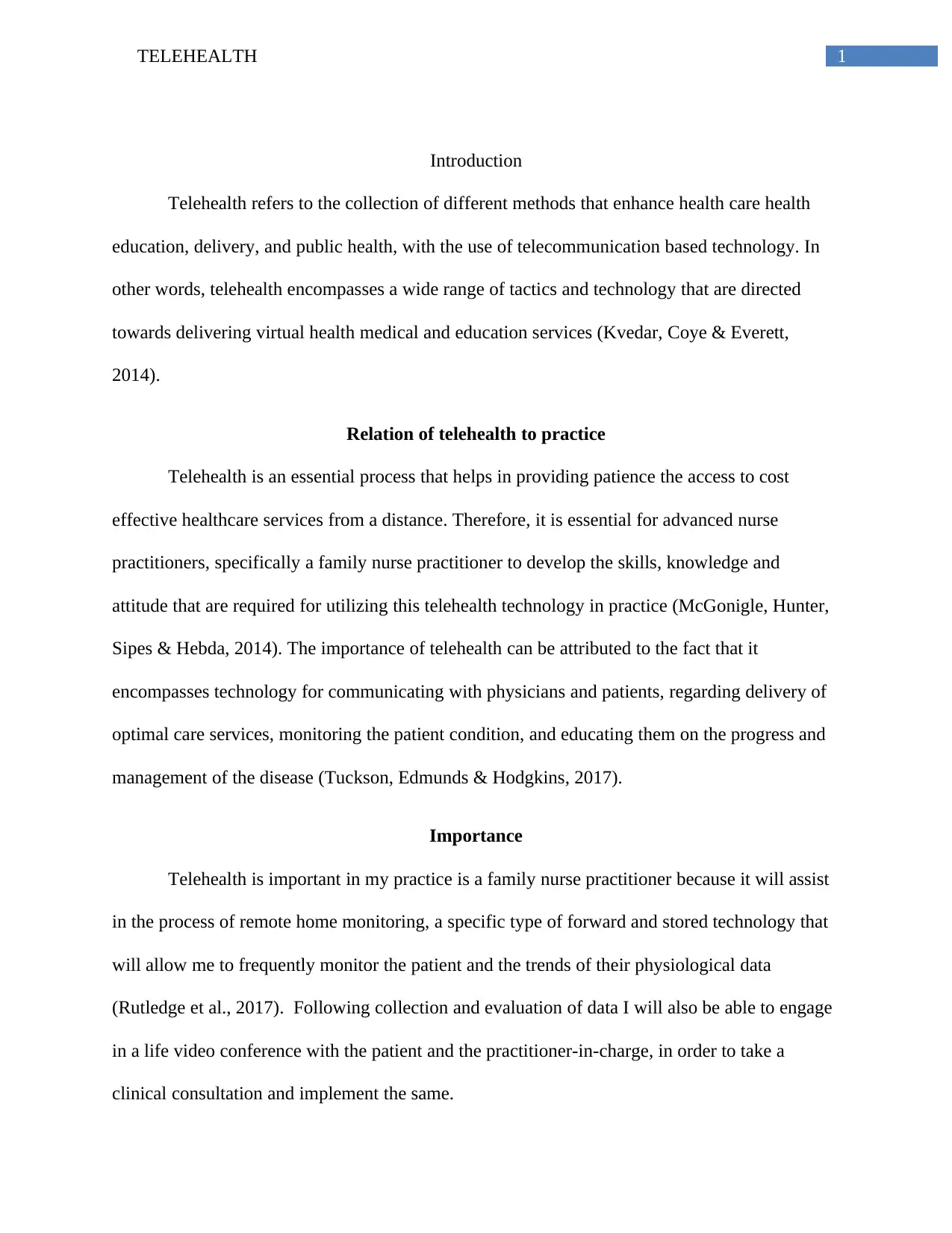
1TELEHEALTH
Introduction
Telehealth refers to the collection of different methods that enhance health care health
education, delivery, and public health, with the use of telecommunication based technology. In
other words, telehealth encompasses a wide range of tactics and technology that are directed
towards delivering virtual health medical and education services (Kvedar, Coye & Everett,
2014).
Relation of telehealth to practice
Telehealth is an essential process that helps in providing patience the access to cost
effective healthcare services from a distance. Therefore, it is essential for advanced nurse
practitioners, specifically a family nurse practitioner to develop the skills, knowledge and
attitude that are required for utilizing this telehealth technology in practice (McGonigle, Hunter,
Sipes & Hebda, 2014). The importance of telehealth can be attributed to the fact that it
encompasses technology for communicating with physicians and patients, regarding delivery of
optimal care services, monitoring the patient condition, and educating them on the progress and
management of the disease (Tuckson, Edmunds & Hodgkins, 2017).
Importance
Telehealth is important in my practice is a family nurse practitioner because it will assist
in the process of remote home monitoring, a specific type of forward and stored technology that
will allow me to frequently monitor the patient and the trends of their physiological data
(Rutledge et al., 2017). Following collection and evaluation of data I will also be able to engage
in a life video conference with the patient and the practitioner-in-charge, in order to take a
clinical consultation and implement the same.
Introduction
Telehealth refers to the collection of different methods that enhance health care health
education, delivery, and public health, with the use of telecommunication based technology. In
other words, telehealth encompasses a wide range of tactics and technology that are directed
towards delivering virtual health medical and education services (Kvedar, Coye & Everett,
2014).
Relation of telehealth to practice
Telehealth is an essential process that helps in providing patience the access to cost
effective healthcare services from a distance. Therefore, it is essential for advanced nurse
practitioners, specifically a family nurse practitioner to develop the skills, knowledge and
attitude that are required for utilizing this telehealth technology in practice (McGonigle, Hunter,
Sipes & Hebda, 2014). The importance of telehealth can be attributed to the fact that it
encompasses technology for communicating with physicians and patients, regarding delivery of
optimal care services, monitoring the patient condition, and educating them on the progress and
management of the disease (Tuckson, Edmunds & Hodgkins, 2017).
Importance
Telehealth is important in my practice is a family nurse practitioner because it will assist
in the process of remote home monitoring, a specific type of forward and stored technology that
will allow me to frequently monitor the patient and the trends of their physiological data
(Rutledge et al., 2017). Following collection and evaluation of data I will also be able to engage
in a life video conference with the patient and the practitioner-in-charge, in order to take a
clinical consultation and implement the same.
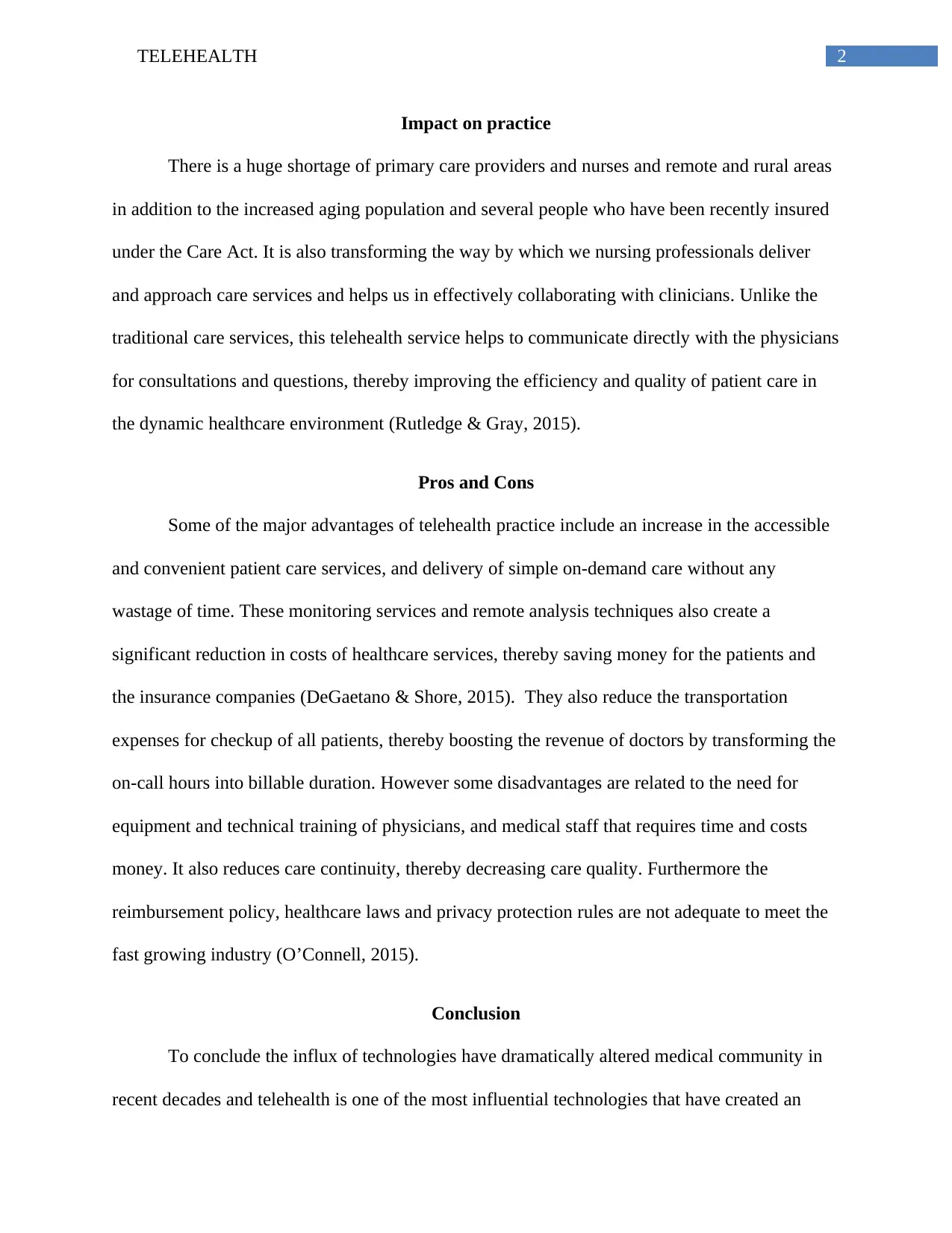
2TELEHEALTH
Impact on practice
There is a huge shortage of primary care providers and nurses and remote and rural areas
in addition to the increased aging population and several people who have been recently insured
under the Care Act. It is also transforming the way by which we nursing professionals deliver
and approach care services and helps us in effectively collaborating with clinicians. Unlike the
traditional care services, this telehealth service helps to communicate directly with the physicians
for consultations and questions, thereby improving the efficiency and quality of patient care in
the dynamic healthcare environment (Rutledge & Gray, 2015).
Pros and Cons
Some of the major advantages of telehealth practice include an increase in the accessible
and convenient patient care services, and delivery of simple on-demand care without any
wastage of time. These monitoring services and remote analysis techniques also create a
significant reduction in costs of healthcare services, thereby saving money for the patients and
the insurance companies (DeGaetano & Shore, 2015). They also reduce the transportation
expenses for checkup of all patients, thereby boosting the revenue of doctors by transforming the
on-call hours into billable duration. However some disadvantages are related to the need for
equipment and technical training of physicians, and medical staff that requires time and costs
money. It also reduces care continuity, thereby decreasing care quality. Furthermore the
reimbursement policy, healthcare laws and privacy protection rules are not adequate to meet the
fast growing industry (O’Connell, 2015).
Conclusion
To conclude the influx of technologies have dramatically altered medical community in
recent decades and telehealth is one of the most influential technologies that have created an
Impact on practice
There is a huge shortage of primary care providers and nurses and remote and rural areas
in addition to the increased aging population and several people who have been recently insured
under the Care Act. It is also transforming the way by which we nursing professionals deliver
and approach care services and helps us in effectively collaborating with clinicians. Unlike the
traditional care services, this telehealth service helps to communicate directly with the physicians
for consultations and questions, thereby improving the efficiency and quality of patient care in
the dynamic healthcare environment (Rutledge & Gray, 2015).
Pros and Cons
Some of the major advantages of telehealth practice include an increase in the accessible
and convenient patient care services, and delivery of simple on-demand care without any
wastage of time. These monitoring services and remote analysis techniques also create a
significant reduction in costs of healthcare services, thereby saving money for the patients and
the insurance companies (DeGaetano & Shore, 2015). They also reduce the transportation
expenses for checkup of all patients, thereby boosting the revenue of doctors by transforming the
on-call hours into billable duration. However some disadvantages are related to the need for
equipment and technical training of physicians, and medical staff that requires time and costs
money. It also reduces care continuity, thereby decreasing care quality. Furthermore the
reimbursement policy, healthcare laws and privacy protection rules are not adequate to meet the
fast growing industry (O’Connell, 2015).
Conclusion
To conclude the influx of technologies have dramatically altered medical community in
recent decades and telehealth is one of the most influential technologies that have created an
⊘ This is a preview!⊘
Do you want full access?
Subscribe today to unlock all pages.

Trusted by 1+ million students worldwide
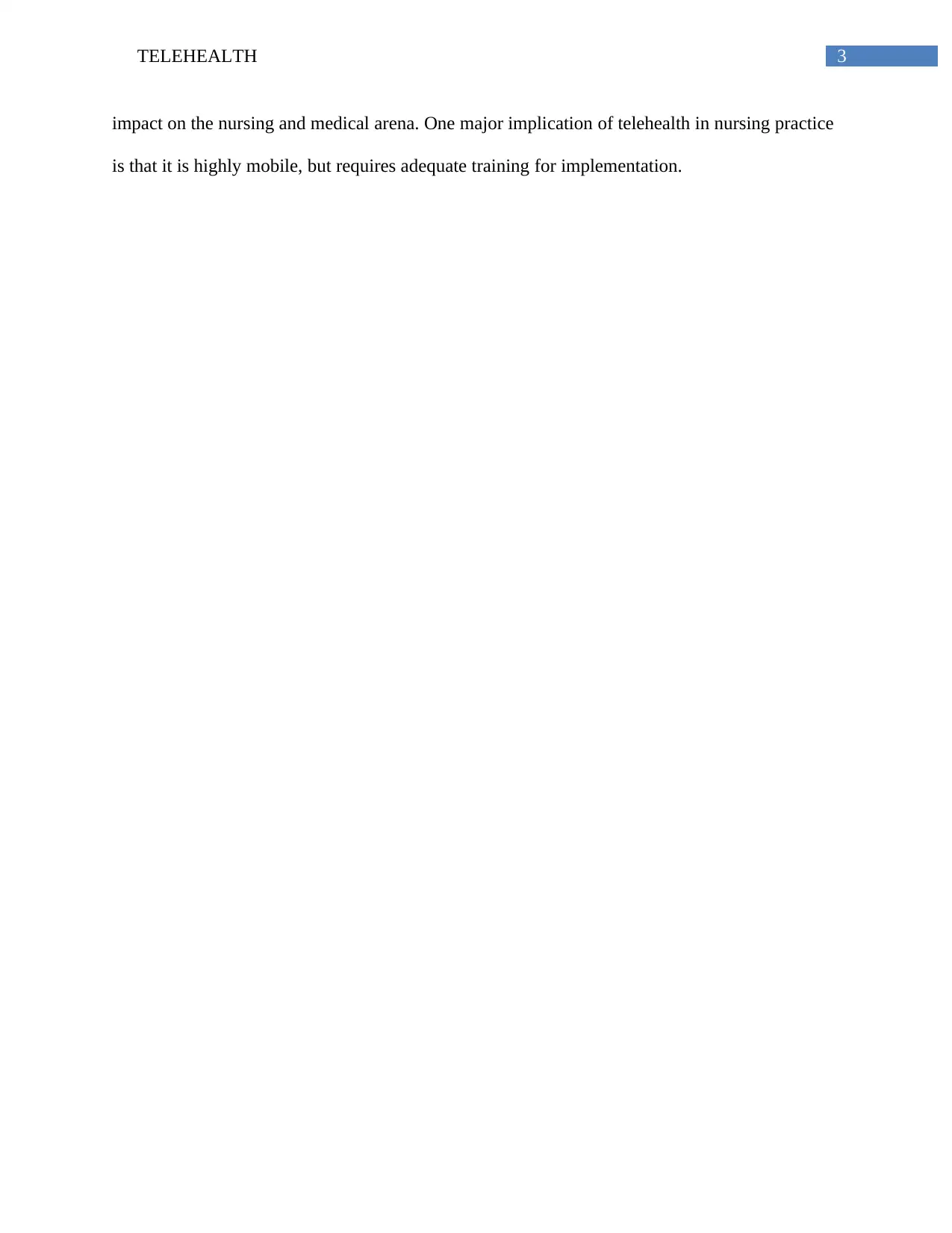
3TELEHEALTH
impact on the nursing and medical arena. One major implication of telehealth in nursing practice
is that it is highly mobile, but requires adequate training for implementation.
impact on the nursing and medical arena. One major implication of telehealth in nursing practice
is that it is highly mobile, but requires adequate training for implementation.
Paraphrase This Document
Need a fresh take? Get an instant paraphrase of this document with our AI Paraphraser
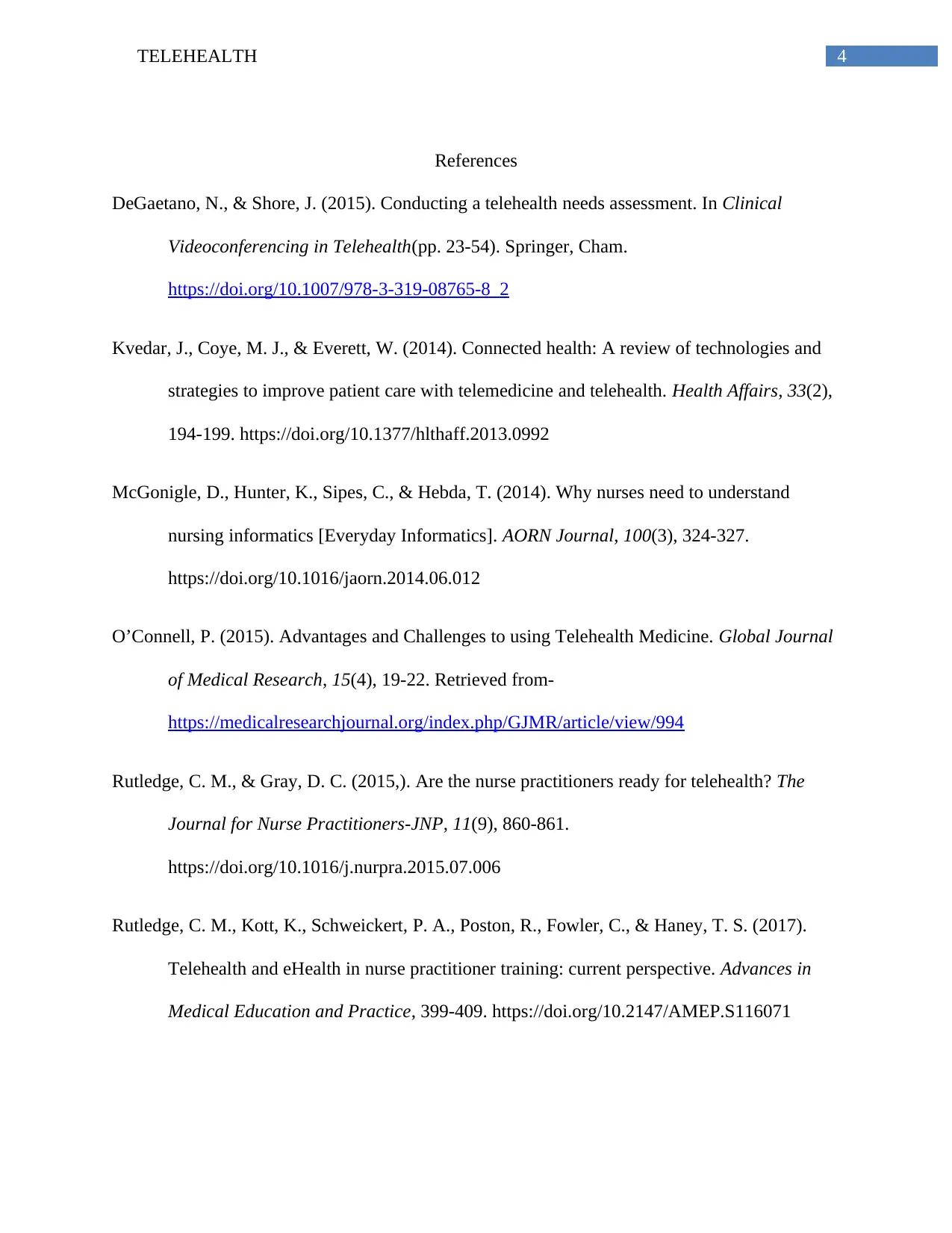
4TELEHEALTH
References
DeGaetano, N., & Shore, J. (2015). Conducting a telehealth needs assessment. In Clinical
Videoconferencing in Telehealth(pp. 23-54). Springer, Cham.
https://doi.org/10.1007/978-3-319-08765-8_2
Kvedar, J., Coye, M. J., & Everett, W. (2014). Connected health: A review of technologies and
strategies to improve patient care with telemedicine and telehealth. Health Affairs, 33(2),
194-199. https://doi.org/10.1377/hlthaff.2013.0992
McGonigle, D., Hunter, K., Sipes, C., & Hebda, T. (2014). Why nurses need to understand
nursing informatics [Everyday Informatics]. AORN Journal, 100(3), 324-327.
https://doi.org/10.1016/jaorn.2014.06.012
O’Connell, P. (2015). Advantages and Challenges to using Telehealth Medicine. Global Journal
of Medical Research, 15(4), 19-22. Retrieved from-
https://medicalresearchjournal.org/index.php/GJMR/article/view/994
Rutledge, C. M., & Gray, D. C. (2015,). Are the nurse practitioners ready for telehealth? The
Journal for Nurse Practitioners-JNP, 11(9), 860-861.
https://doi.org/10.1016/j.nurpra.2015.07.006
Rutledge, C. M., Kott, K., Schweickert, P. A., Poston, R., Fowler, C., & Haney, T. S. (2017).
Telehealth and eHealth in nurse practitioner training: current perspective. Advances in
Medical Education and Practice, 399-409. https://doi.org/10.2147/AMEP.S116071
References
DeGaetano, N., & Shore, J. (2015). Conducting a telehealth needs assessment. In Clinical
Videoconferencing in Telehealth(pp. 23-54). Springer, Cham.
https://doi.org/10.1007/978-3-319-08765-8_2
Kvedar, J., Coye, M. J., & Everett, W. (2014). Connected health: A review of technologies and
strategies to improve patient care with telemedicine and telehealth. Health Affairs, 33(2),
194-199. https://doi.org/10.1377/hlthaff.2013.0992
McGonigle, D., Hunter, K., Sipes, C., & Hebda, T. (2014). Why nurses need to understand
nursing informatics [Everyday Informatics]. AORN Journal, 100(3), 324-327.
https://doi.org/10.1016/jaorn.2014.06.012
O’Connell, P. (2015). Advantages and Challenges to using Telehealth Medicine. Global Journal
of Medical Research, 15(4), 19-22. Retrieved from-
https://medicalresearchjournal.org/index.php/GJMR/article/view/994
Rutledge, C. M., & Gray, D. C. (2015,). Are the nurse practitioners ready for telehealth? The
Journal for Nurse Practitioners-JNP, 11(9), 860-861.
https://doi.org/10.1016/j.nurpra.2015.07.006
Rutledge, C. M., Kott, K., Schweickert, P. A., Poston, R., Fowler, C., & Haney, T. S. (2017).
Telehealth and eHealth in nurse practitioner training: current perspective. Advances in
Medical Education and Practice, 399-409. https://doi.org/10.2147/AMEP.S116071

5TELEHEALTH
Tuckson, R. V., Edmunds, M., &Hodgkins, M. L. (2017, Octuber 17). Telehealth. The New
England Journal of Medicine, 377, 1585-1592. https://doi.org/10.1056/NEJMsr1503323
Tuckson, R. V., Edmunds, M., &Hodgkins, M. L. (2017, Octuber 17). Telehealth. The New
England Journal of Medicine, 377, 1585-1592. https://doi.org/10.1056/NEJMsr1503323
⊘ This is a preview!⊘
Do you want full access?
Subscribe today to unlock all pages.

Trusted by 1+ million students worldwide
1 out of 6
Related Documents
Your All-in-One AI-Powered Toolkit for Academic Success.
+13062052269
info@desklib.com
Available 24*7 on WhatsApp / Email
![[object Object]](/_next/static/media/star-bottom.7253800d.svg)
Unlock your academic potential
Copyright © 2020–2025 A2Z Services. All Rights Reserved. Developed and managed by ZUCOL.




